The top military static control packaging solutions you'll need include five-layer static shielding bags, ESD protective films, custom-sized anti-static pouches, MIL-PRF-81705E compliant moisture barriers, and hard-shell static control cases. You can also rely on military-grade cushioning materials like Ethafoam M-Series, ESD-safe tapes and labels, static dissipative containers, polyimide films with high-temperature resistance, and four-layer static shielding films. These solutions create Faraday Cage effects, protect against moisture, and meet strict Department of Defense specifications. Understanding the full capabilities of these protective options will guarantee your sensitive electronics remain safe and mission-ready.
Military Static Shielding Bags
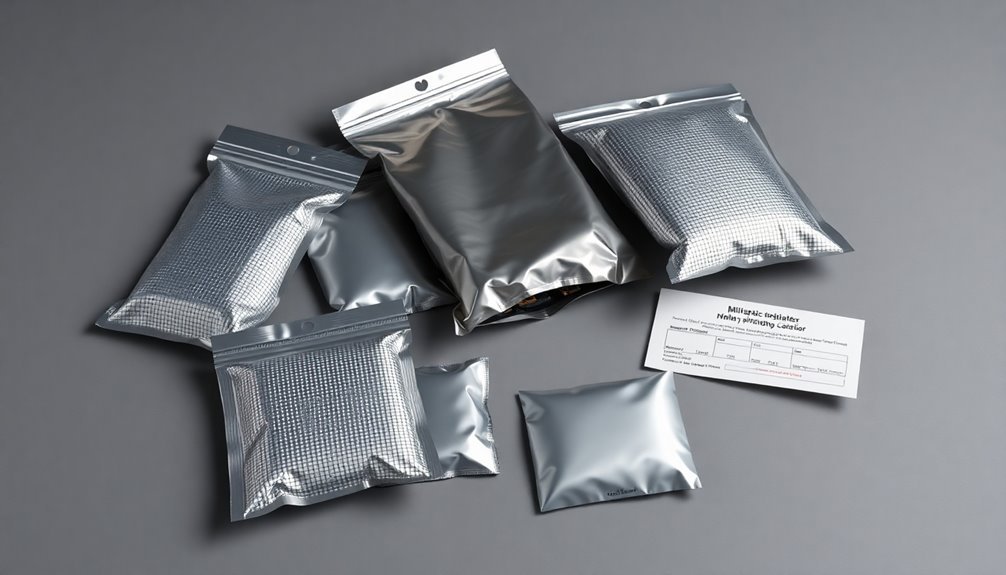
Military static shielding bags' five-layer construction forms the backbone of modern ESD protection for sensitive electronic components. The metal-in design creates a Faraday Cage effect, which shields your sensitive military electronics from harmful static discharges and external electrical interference. Same-day shipping is available for stock military static shielding bags to ensure rapid deployment readiness.
These specialized bags achieve 40% light transparency while maintaining full protective capabilities. You'll find these bags available in various thicknesses ranging from 3.1 to 8 mil, letting you choose the right level of protection for your specific needs.
When you're handling critical military components like missile parts or explosive devices, you'll appreciate the bags' superior moisture barrier and puncture resistance. The specialized polyethylene layers minimize tribocharging, while the metalized layer provides consistent static shielding that meets MIL-PRF-81705E TY III and ANSI/ESD S20.20 standards.
You can select from transparent, semi-transparent, or opaque options, depending on your visibility requirements. The bags are heat-sealable and can be custom-sized to fit your exact specifications.
For long-term storage solutions, you'll benefit from their robust moisture protection and reliable ESD shielding capabilities. They're also cost-effective compared to alternative protection methods, making them an efficient choice for your military packaging needs.
ESD Protective Film Solutions
When you're selecting military-grade ESD protective films, you'll need to evaluate specialized options like anti-static polyimide and static shielding films that meet strict military specifications.
Your barrier protection requirements will determine whether to use moisture barrier films for sensitive components or EMI shielding films for electronics exposed to electromagnetic interference. These films feature acrylic or silicone adhesive coatings that ensure clean removal without leaving residue. High-temperature resistance up to 400°C makes polyimide film especially suitable for demanding military applications.
To maximize your budget while maintaining military compliance, focus on films that offer multiple protective features, such as those combining moisture resistance with static dissipation capabilities.
Military-Grade ESD Film Types
Several critical ESD film types serve as the backbone of military-grade static control packaging. You'll find three primary categories that meet stringent military specifications: static shielding films, ESD/EMI moisture barrier films, and polyimide ESD films. Each type offers unique protective properties for sensitive military electronics. The four-layer construction of static shielding bags includes static dissipative coating, polyester, metal, and polyethylene layers for maximum protection. CGS specializes in providing electrical insulation solutions for these military applications.
| Film Type | Key Properties | Primary Applications |
|---|---|---|
| Static Shielding | Four-layer structure with MIL-PRF-81705E Type III compliance | Electronic device handling and storage |
| ESD/EMI Moisture Barrier | Three-layer construction with 100-micron thickness | Long-term protection with moisture resistance |
| Polyimide ESD | High-temperature stability with 1-2 mil thickness | Aerospace and military electronics insulation |
When you're selecting military-grade ESD films, you'll need to evaluate your specific application requirements. Static shielding films excel in discharge protection with their metal layer construction, while moisture barrier films provide additional protection against water and vapor intrusion. For high-temperature applications, you'll want to opt for polyimide ESD films, which maintain their protective properties even under extreme conditions. All these solutions comply with relevant military standards, including MIL-DTL-117H and MIL-PRF-81705F specifications.
Barrier Protection Technology Applications
Modern barrier protection technology's core strength lies in its diverse ESD protective film solutions. You'll find specialized films like ESD PET, static shielding, and conductive films protecting sensitive military equipment from electrostatic discharge. These solutions offer customizable surface resistivity ranging from 10^5 to 10^11 Ω, ensuring ideal protection for your specific needs.
When you're working with military-grade electronics, you'll need robust barrier protection that includes:
- Multi-layered ESD PET films with acrylic or silicone adhesive coatings that dissipate static electricity
- High-transparency films allowing clear visual inspection while maintaining complete static protection
- Chemical-resistant laminating films that protect documentation in static-controlled environments
You can rely on these protective solutions across various military applications, from electronics manufacturing to cleanroom operations. The dimensional stability of these films prevents warping or distortion during extreme environmental conditions. PEDOT:PSS coatings create an essential conductive layer that captures and disperses harmful static charges.
The films' thickness variations (50µm to 100µm) provide flexibility in meeting different protective requirements. When you're handling sensitive components in aerospace or telecommunications applications, you'll appreciate the dual benefits of static discharge protection and physical barrier properties.
These films don't just prevent ESD damage – they're also cost-effective solutions for long-term storage and transportation of military-grade electronic components.
Cost-Effective Film Selection Guide
Building on our understanding of barrier protection technologies, selecting the right ESD protective film requires careful evaluation of both performance and cost factors.
You'll find conductive black film offers the most economical solution for basic electronics protection while maintaining RoHS compliance. For maximum protection of sensitive components like PCBs and ICs, you should opt for static shielding film, though it comes at a higher price point. Carbon black additives help enhance the electrical conductivity of these protective films.
When you're working with high-temperature applications in aerospace or military settings, anti-static polyimide film provides the necessary thermal resistance and insulation. Special films are specifically designed to mitigate ESD risks in electrical components.
If you need cushioning protection along with static control, you'll want to assess anti-static bubble film for your secondary packaging needs. For document storage, ESD laminating film offers both static protection and chemical resistance.
To guarantee you're making a cost-effective choice, verify the material specifications match your requirements.
Look for point-to-point resistance values between 1.0*10^4 and 1.0*10^9 Ω, and confirm the electrostatic value doesn't exceed ±100V.
You can use economical test equipment to check these specifications before committing to bulk purchases.
Custom Anti-Static Packaging Options
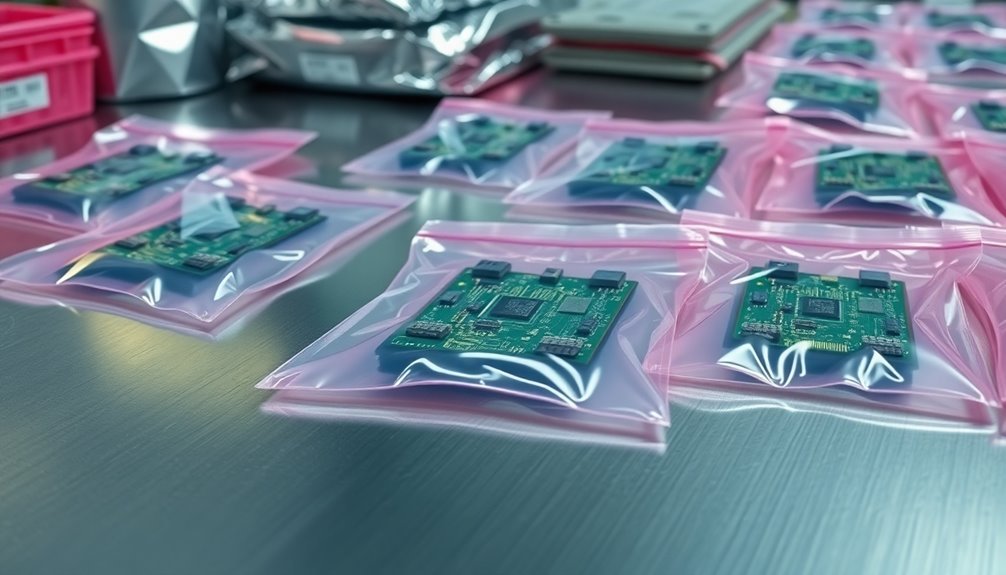
You'll find an extensive range of military-grade anti-static packaging materials, including MIL-PRF-81705E static shielding bags and MIL-DTL-117H moisture barrier bags, designed to meet your specific ESD protection needs.
Your sensitive components can be protected with custom-sized packaging solutions featuring Faraday Cage protection, conductive poly films, and integrated moisture control systems.
Whether you need small pouches or large-format bags, these military-approved packaging options come with flexible sizing configurations and can include specialized features like humidity indicators and desiccant packets.
Military-Grade Material Options
Selecting the right military-grade static control materials demands precise understanding of protection requirements and compliance standards.
You'll find MIL-PRF-81705E Type I Class I at the forefront of static shielding solutions, offering extensive ESD/EMI protection for sensitive electronics and circuit assemblies.
When you need maximum moisture barrier protection, MIL-DTL-117H Type I Class F Style I bags deliver superior performance while maintaining static shielding capabilities.
For specialized applications, consider these military-grade options:
- MIL-P-82646 Rev B black conductive poly film for handling explosive materials and chemicals
- CP BLACKSTAT 100's multilayer construction combining compressed carbon and polyethylene
- MIL-PRF-81705 Type III Class II film for Faraday Cage protection of circuit boards
You'll achieve ideal protection by matching your material selection to specific environmental threats.
For moisture-sensitive components, you can combine static shielding bags with desiccant packets and VCI paper.
The 40% light transparency of ESD packaging materials allows for easy visual inspection while maintaining protection integrity.
When you're dealing with custom requirements, military-grade cushioning products and protective inserts can be integrated to meet precise IP specifications.
Flexible Sizing and Configurations
Military manufacturers have developed versatile sizing options and custom configurations to meet precise anti-static packaging requirements.
You'll find roll stock and sheets made from MIL-PRF-81705E Type I Class I materials that you can customize to your exact specifications, while companies like IPS offer custom flexographic printing up to three colors for your barrier materials.
You can choose from reclosable anti-static bags with adjustable sizing options, and complement them with die-cut foam inserts for precise equipment fitting.
For complex military components, like the Sea Sparrow Missile's guidance system, you'll discover specialized packaging solutions that incorporate moisture barriers and desiccants to protect against corrosion and humidity.
When you need to protect multiple components, you can opt for configurable cases with custom inserts that meet IP67 and IP68 ratings.
Companies like SmartShield, Nanuk, and Pelican provide military-grade hard plastic cases that you can adapt to your specific needs.
For additional protection, you'll have access to specialized materials such as VCI paper and military tape, ensuring your equipment remains secure and static-free during storage and transport.
Mil-Spec Moisture Barrier Materials
According to military specifications, moisture barrier materials must meet rigorous standards to protect sensitive equipment and components. You'll find that MIL-PRF-131L Class 1 leads the category as a water-vapor-proof foil laminate that's been extensively tested and approved by US Naval Labs.
When you're selecting moisture barrier materials, look for suppliers who offer products with verified WVTR rates below 0.0005 gms/100 sq in/24 hrs and heat-sealing capabilities at 500℉.
For maximum protection, you'll want materials that demonstrate these critical features:
- Double-layered seam construction that remains intact across temperature extremes
- Multi-layer composition using Mylar foil and aluminum combinations
- Puncture-resistant surfaces that maintain barrier properties even after flexing
Leading manufacturers like 3D Barrier Bags Inc. and IMPAK Corporation provide mil-spec materials that undergo rigorous testing for leakage, separation, and delamination.
You'll need to verify that your chosen packaging includes proper tracking information, including material codes, manufacturer details, and lot numbers.
Remember that different variations, such as MIL-PRF-121G and MIL-PRF-22191F, are available for specific protection requirements, allowing you to match the barrier properties to your exact needs.
Static Control Storage Cases
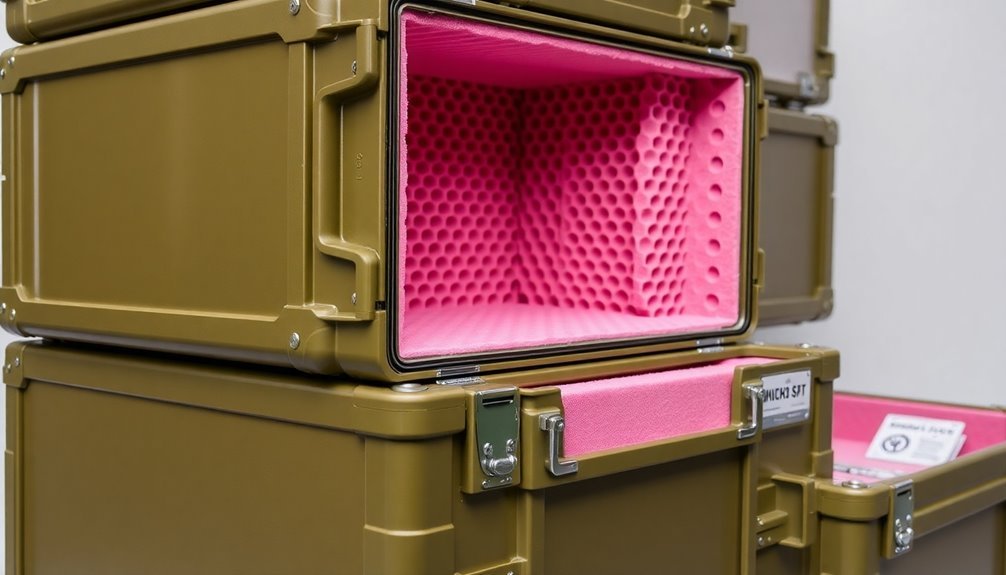
When you're protecting sensitive military electronics, hard shell static control cases offer exceptional durability combined with advanced ESD safeguards.
You'll find these military-grade cases incorporate rigid outer shells with specialized static-dissipative materials, creating a thorough defense against both physical damage and harmful electrostatic discharge.
The key features of military static control cases include Mil-Spec compliance, Faraday cage protection, and customizable interior configurations to secure your specific electronic components.
Hard Shell Protection Benefits
Hard shell protection offers four primary advantages for military static control storage: physical defense, static dissipation, environmental shielding, and long-term cost savings.
When you're protecting sensitive military equipment, you'll find that hard shell cases provide superior protection through their durable construction using materials like molded foam and polycarbonate.
The static control benefits are particularly essential for military applications. You'll get thorough static protection through:
- Anti-static materials that prevent charge buildup
- Static shielding films that block electrostatic discharge
- Custom-cut foam inserts that provide both cushioning and static dissipation
Your equipment stays safe from environmental threats thanks to sealed designs that keep out moisture and dust.
The cases can be engineered to meet specific military standards, including MIL-PRF-81075 compliance for static control. They'll also shield against EMI and RFI when properly configured.
While the initial investment might seem substantial, you're actually saving money in the long run.
By preventing equipment damage and reducing the need for repairs or replacements, these cases prove cost-effective.
You'll especially appreciate their durability during long-term storage and frequent transport scenarios.
Key Features Military Cases
Military static control storage cases come equipped with a detailed set of features designed to protect sensitive electronic equipment.
You'll find these cases incorporate multiple layers of protection, including ESD-resistant materials like MIL-PRF-81705E Type I and MIL-DTL-117H Type I bags that shield against static, moisture, and vapor damage.
The cases feature customizable foam inserts that you can adapt to your specific electronic components, while fully-sealed designs meeting IP67 and IP68 ratings guarantee complete protection from environmental hazards.
You'll benefit from Faraday cage protection through MIL-PRF-81705 Type III Class II materials, which provide essential electrostatic shielding.
For moisture control, these cases integrate VCI and desiccant packets, along with humidity indicators that let you monitor internal conditions.
You're also getting EMI protection and corrosion resistance through VCI papers and specialized materials.
Every case meets strict military specifications, including ATA Spec 300 and ISPM-15 HT certification, while manufacturers maintain ISO 9001 certification for consistent quality.
When you're handling sensitive military electronics, you can rely on these cases' extensive static control features to maintain your equipment's integrity.
Corrosion Prevention Packaging Systems
Modern corrosion prevention packaging systems combine multiple technologies to safeguard sensitive military equipment against environmental threats.
You'll find high-barrier films and VCI paper working together with desiccant bags to create a thorough defense against moisture, static, and corrosion. These systems meet rigorous MIL-SPEC requirements, including MIL-PRF-81705E Type I Class I for moisture vapor protection and Type III Class II for static control.
When you're protecting military components, you'll need packaging that provides:
- Multi-layer barrier bags that block moisture while maintaining static-safe environments
- Vapor Corrosion Inhibitor materials that actively prevent rust and oxidation
- Desiccant systems with humidity indicators to monitor and control moisture levels
You can customize your corrosion prevention strategy based on specific storage and shipping requirements.
The combination of moisture barrier bags, VCI technology, and humidity control systems guarantees long-term protection for sensitive equipment. These solutions don't just meet military specifications – they're designed to maintain integrity throughout extended storage periods and challenging transit conditions.
Military Grade Cushioning Materials
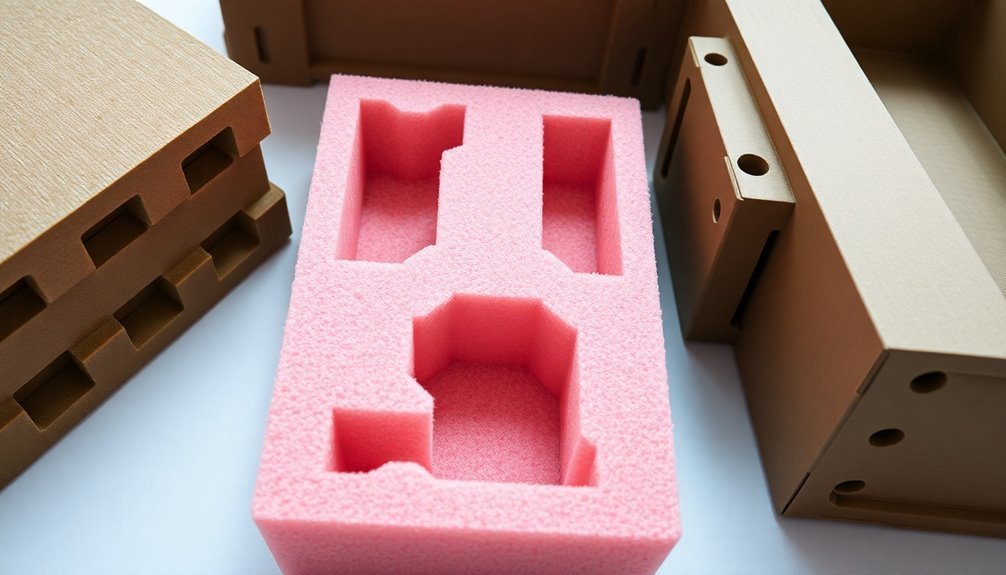
Selecting the right cushioning materials for military equipment requires deep knowledge of specifications and performance characteristics.
You'll find that Ethafoam M-Series leads the market with densities ranging from 2.3 pcf to 10 pcf, meeting CID A-A-59136 and PPP-C-1752 requirements. For electronic components, you can utilize the anti-static pink version to guarantee protection from electrical discharge.
When you're choosing between polyethylene and polyurethane foams, consider their specific military standards.
Polyethylene foams comply with A-A-59135 and PPP-C-1752, while polyurethane foams meet MIL-P-26514 specifications. You'll benefit from their oil and fuel resistance, excellent energy absorption, and long-term storage stability.
You can select from various thicknesses (1/2 inch, 1 inch, 2 inch) and custom-cut sheets for your specific packaging needs.
For specialized applications, you'll find options like Zotefoams and flame-retardant variants. When you're working with military contracts, guarantee your materials comply with MIL-STD-2073-1 for preservation methods.
Partner with authorized Dow Chemical fabricators to ensure your cushioning materials meet all military requirements and specifications.
ESD Tape and Labels
Numerous ESD tapes and labels serve as vital components in military static control packaging. You'll find these specialized tapes manufactured from various materials, including polyimide, vinyl, and polyethylene, each designed to prevent static damage during military operations.
When selecting ESD tapes for military applications, you'll need to take into account their specific anti-static properties and high-temperature tolerance, especially for applications involving wave soldering or extended exposure to heat.
For military-grade packaging solutions, you'll want to focus on these important features:
- Conductive adhesives that guarantee clean peeling and minimal outgassing
- Static dissipative surfaces with embedded conductive grids
- High conformability for sealing irregular surfaces and corners
Your military packaging requirements will often demand tapes that comply with federal specifications and ESD standards. These tapes aren't just for sealing – they're essential for labeling static-sensitive components, marking hazard warnings, and guaranteeing proper handling procedures.
When working in cleanroom environments, you'll need tapes specifically processed and packaged to meet stringent military cleanliness standards. Remember to choose tapes with appropriate temperature ratings and static dissipation properties for your specific military application.
Static Dissipative Containers
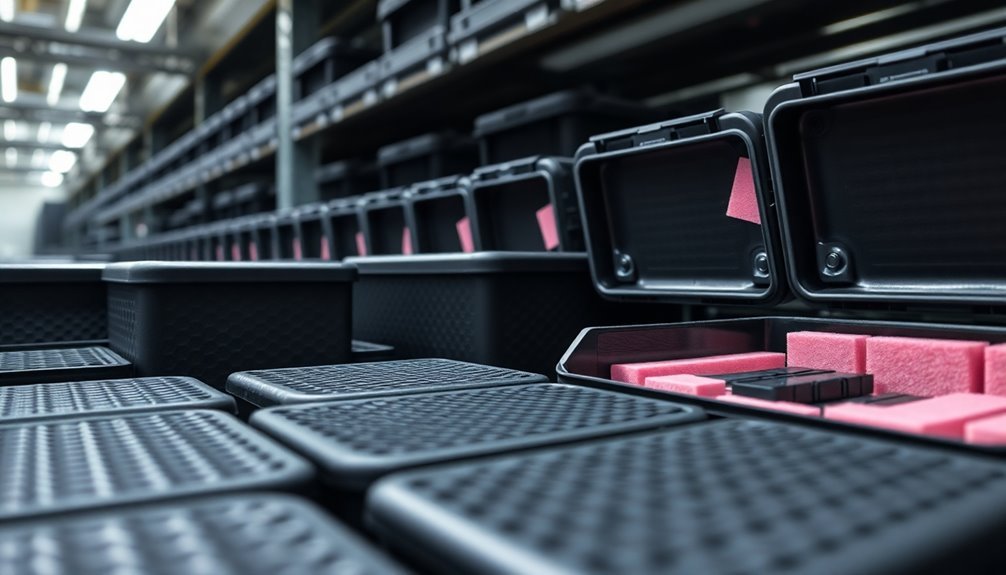
Military-grade static dissipative containers form the backbone of ESD protection in defense applications. When you're selecting containers, you'll need to take into account specific military standards like MIL-PRF-81705 Type I Class I, which provides thorough protection including ESD, EMI shielding, and moisture vapor barriers.
You'll find three main material categories for static control: anti-static (ASP), static dissipative (BAS), and conductive (CAS). Each offers different surface resistivity ranges to match your specific needs. For electronics and sensitive components, you'll want static dissipative materials with resistivity between 10^8 and 10^11 ohms/square.
If you're handling explosives, black conductive polyethylene containers are your best choice.
To maintain compliance, you must follow DLA packaging requirements and MIL-STD-129 for proper marking. When you're procuring containers for military applications, verify they meet MIL-STD-2073-1 specifications.
This is vital for aerospace components, medical equipment, and laboratory environments where ESD protection is critical. Remember, using containers that meet these military specifications isn't just about compliance – it's necessary for protecting sensitive equipment and maintaining the integrity of your supply chain.
Defense-Rated Packaging Compliance Standards
While static dissipative containers offer essential protection, they must align with an extensive set of defense-rated packaging standards. You'll need to comply with MIL-STD-2073, which provides thorough guidelines for military packaging development and documentation. This standard outlines four protection levels, from Level A (maximum) to Level D (internal transfers), guaranteeing your items receive appropriate safeguarding.
To meet defense packaging requirements, you'll find these critical elements must be present:
- Vapor-proof barriers and desiccants to control moisture and prevent corrosion
- Clear labeling with National Stock Numbers, part numbers, and handling instructions
- Documented test results for water vapor transmission, seam strength, and puncture resistance
Your packaging solutions must also comply with MIL-STD-129 for shipping markings and MIL-STD-130 for inventory management identification.
Don't overlook ESD control requirements when handling sensitive electronic components. You'll need to maintain detailed documentation of your packaging specifications and test results, as non-compliance can lead to delays, damaged goods, or safety hazards.
Regular quality control monitoring and proper certifications from the DoD and DLA will guarantee your packaging meets all necessary standards.
Frequently Asked Questions
How Long Can Static Control Packaging Maintain Its Protective Properties in Storage?
Your static control packaging can maintain its protective properties for up to 5 years when stored in controlled environments. You'll need to minimize exposure to heat, moisture, and sunlight while conducting annual testing.
What Temperature Ranges Can Military-Grade Static Control Packaging Safely Withstand?
You can rely on military-grade static control packaging to withstand temperatures from -22°C to 63°C (-4°F to 145°F). It's also designed to handle temperature shocks with changes up to 10°C per minute.
Can Static Control Packaging Be Reused Without Compromising Its Protective Qualities?
You shouldn't reuse static control packaging as it'll compromise protection. Material degradation, static charge buildup, and contamination risks increase with each use. Manufacturers specifically recommend single-use to maintain ideal protective qualities.
Are There Specific Disposal Requirements for Military Static Control Packaging Materials?
You'll need to follow strict DoD and EPA regulations when disposing of static control packaging. You must segregate materials, use authorized facilities, maintain disposal records, and guarantee proper handling of hazardous components.
How Quickly Does Static Dissipative Packaging Neutralize Electrostatic Charges After Contact?
You'll find that static dissipative packaging typically neutralizes charges within seconds to minutes after contact, but the exact speed depends on factors like conductivity, material thickness, humidity, and initial charge intensity.
In Summary
You'll find that implementing proper static control packaging is essential for protecting sensitive military equipment and maintaining operational readiness. By choosing from these top solutions, you're ensuring compliance with military standards while safeguarding valuable electronics and components. Remember to regularly assess your packaging needs and update your materials to match the latest Mil-Spec requirements. Don't compromise on quality when it comes to ESD protection.

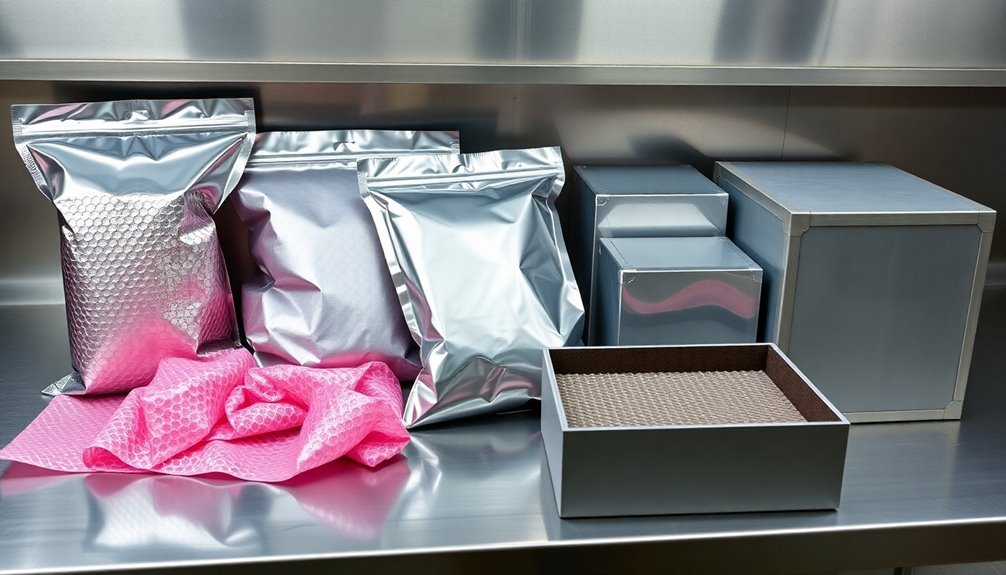



Leave a Reply